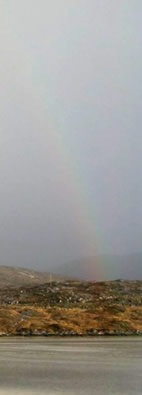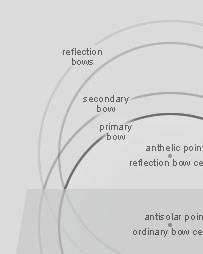
OpticsPOD
What's New
Rays & Shadows
Water Droplets
Rainbows
Not a rainbow!
Primary Bow
Secondary Bow
A's Dark Band
Other Orders
Supernumeraries
Red Bows
Rainbow Wheel
Dew Bow
Sea Spray Bow
Glass Bead Bows
Reflection Bows
Formation
Reflected Bows
Twinned Bows
Cloud Bows
Moon Bows
Image Gallery
Simulators
Ice Halos
High Atmosphere
Links & Resources
Search - Index
123456789012345678
| Reflection Rainbows |
|
More reflection & reflected bows 1,2,3,4,5,6 There are at least four rainbows in the scene at left. The strangely oriented bow curving between the primary and secondary is a primary 'reflection rainbow' produced by sunlight beaming upwards after reflection from calm water or wet sand. In this instance the sun's rays were reflected from another bay behind the camera. And the fourth bow? Look in the wet sand. There is a fragment of bow. This is a 'reflected rainbow'. The Scottish Western Isles are favoured places for reflection bows. The prevailing warm south westerlies from the Atlantic Ocean bring frequent showers of fine rain interspersed by skies of exceptional purity whose sunlight is reflected in the many bays and inlets. More reflection bows 1,2. |
|||||||||||
|
The centres of reflection bows are at the same altitude as the sun - the anthelic point. This is the same distance above the horizon as the centres of normal bows are below it at the antisolar point. The normal bow and its corresponding reflection bow intersect at the horizon. Reflection bows are usually brightest when the sun is low because then its light is reflected most strongly from water surfaces. The normal and reflection bows draw closer together as the sun gets lower. The source of the reflected light is usually water behind you, i.e. sunwards. It can be in front of you but then only the base of the reflected bow will be seen. |
|||||||||||






